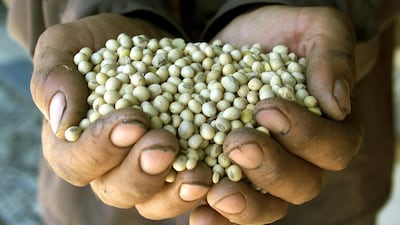Vandalised crop trials, claims of "Frankenstein foods" and persistent concerns over environmental and public safety – genetically modified organisms rarely fail to generate controversy.
The latest development in the decades-long GMO saga is the government's recent announcement that it is introducing a Federal Law on Biosafety of Genetically Modified Organisms.
The Cabinet-approved law is designed to safeguard public health from risks linked to GMOs or their products.
The rules are likely to "reflect people's priorities and preferences in the country", according to Lynn Frewer, a professor of food and society at Newcastle University in the United Kingdom. "It might be an attempt to generate trust in the regulatory practices, as it's responding to public views," Prof Frewer said.
The depth of feeling and concern that GMOs can generate is considerable.
In some parts of the world, particularly Europe, anti-GMO protesters have taken direct action.
Few know this better than Prof Wendy Harwood, a senior scientist at the John Innes Centre, a plant sciences research institute in Norwich in East England.
Prof Harwood was running a trial on genetically modified barley in 2001 when activists attacked the project.
“People came in and destroyed it here on the John Innes Centre site,” she said.
The new law in the UAE comes a year after it was announced that Dubai Central Laboratory was carrying out screening of foods to ensure that GMOs were labelled correctly.
In 2011, a study by scientists at Abu Dhabi Food Control Authority confirmed that GMO foods were being sold in the Emirates, with 16 out of 128 food samples tested containing GMO material, mostly soya or corn.
The authors noted at the time that there was "no legislation on GM labelling and the cultivation of GM crops in the UAE".
Currently, about one in three countries worldwide has mandatory GMO labelling.
Habiba Al Marashi, the chairwoman of Emirates Environmental Group, said that consumer choice was important.
"EEG believes it can be left to the consumers to choose whether they would like to purchase an organic, GMO or alternatively grown product, on the condition that the consumers have been educated and given enough awareness," she said.
With Europe having long had significant opposition to the growing of GMOs, the United States has led the way in their use, with commercial growing starting there in the mid-1990s.
Part of the GMO controversy stems from what some GM plants have been engineered for. An example is soya engineered for resistance to a herbicide, Roundup, which allows growers to apply the herbicide and kill other plants while leaving the crop intact.
Such applications of GMO technology have led the environmental group Greenpeace to say that the growing of GMOs has resulted in greater pesticide and chemical use.
There has also been an effect on public opinion.
“There’s evidence people perceive the benefits to accrue to producers ... and they’re very small to consumers,” said Prof Frewer, who has been a member of a scientific advisory board on GM and sustainable food production at Mistra, a Swedish environmental research foundation.
Genetic engineering dates back to the 1970s, with early experiments involving bacteria and mice.
GMOs, whether mammals, plants, bacteria or fungi, have had genes added to their genetic material after those genes were isolated from another organism.
Genes from everything from bacteria to fish can be transferred into plants, with one celebrated example involving the transfer of an antifreeze gene from a fish into tomatoes.
Environmental campaigners are concerned that genes inserted into GM plants could escape into wild plants, with ecological consequences – for example, if a gene that made a crop plant resistant to an insect pest was taken up by wild plants, it could devastate populations of that insect.
At a discussion at the UAE's Federal National Council in 2014, members were told that the concerns linked to GMOs were about their potential environmental and biodiversity effects, not food safety.
More recently, a technique known as gene editing was developed. This involves using specialised proteins that can make precise changes to an organism's genetic material, which can include adding or removing a section of DNA.
Advocates of GM technology argue that while the GM crops and health concerns over GM food generate controversy, other applications of the same technology are widely accepted.
Prof Johnathan Napier, who has genetically engineered crops to produce fish oils that offer health benefits, said insulin injected by diabetics, washing powders and cheese ingredients are all often produced by GMOs.
“The evidence that they are safe for human health and the environment is overwhelmingly compelling. I certainly wouldn’t be doing my experiments if I thought there was a risk,” he said.
Greenpeace, meanwhile, states in a briefing document that while "giant agricultural firms" say GMOs are not harmful to people, "the world doesn't have enough evidence to make that absolute claim".
Prof Harwood, who says that GMO crop trials today generate less controversy than they used to, insists that whether a plant is a GMO is irrelevant to the question of whether it is safe to eat or is environmentally hazardous.
She said assessments should be carried out on a case-by-case basis, because “the method itself is safe”.


